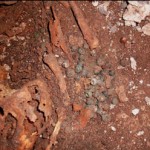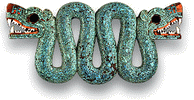Burial Discovered at Bonampak Building
Category: News reports January, 08, 2010. INAH. The search of adequate conservation of Bonampak mural paintings, located in Chiapas, turned out into the discovery of a crypt under the second room of Templo de las Pinturas (Temple of the Paintings) with rests of a man accompanied with jadeite ornaments and ceramic objects that could be more than 1,300 years old.
January, 08, 2010. INAH. The search of adequate conservation of Bonampak mural paintings, located in Chiapas, turned out into the discovery of a crypt under the second room of Templo de las Pinturas (Temple of the Paintings) with rests of a man accompanied with jadeite ornaments and ceramic objects that could be more than 1,300 years old.
The unknown character’s rests could correspond to a war captive such as those represented in La Batalla mural, or a relative of Chaan Muan II, who ruled Bonampak from 776 to 792 of the Common Era.
The discovery results from the multidisciplinary project conducted by the National Institute of Anthropology and History (INAH), through its National Coordination of Archaeology and of Cultural Heritage Conservation (CNCPC), with institutional resources. The objective of the project was to determine features of the soil where the building stands, to implement an optimal method to conserve the Prehispanic paintings.
By using ground penetrating radar (GPR) in the temple’s surface, engineer Jose Ortega detected a void where a funerary crypt was located after excavation.
The burial has been dated towards the end of 8th century, during the government of Chaan Muan II, identified as the last ruler of Bonampak. He ordered the creation of the Temple of the Paintings, integrated by 3 rooms completely decorated with paintings over the throne, walls and vaults.
Archaeologist Alejandro Tovalin Ahumada, director of the excavation, informed that the discovery consists on a 75 centimeters high’ simple funerary crypt, which measures 2.20 by 0.70 meters, and a white stucco-covered vault which is 35 centimeters high.
Inside were found osseous rests of a man with the skull missing: only jawbone was located. At his feet, 2 polychrome dishes were placed, and next to the place of the skull, a perforated alabaster vase was found. According to preliminary studies conducted by physical anthropologist Javier Montes, this man would have been 1.70 meters high and between 35 and 42 years old at the time of death.
Regarding the identity of the buried person, Tovalin specified that none of the objects of the offering have hieroglyphs that provide information, but archaeological material has allowed formulation of 2 hypothesis: The first one indicates he might have been a war captive sacrificed as an offering, which supported by the absence of skull, and the perforated alabaster associated to the knife. The second hypothesis points out to a close relative of Chaan Muan II.
The character was dressed up with a Spondylus shell pectoral; a necklace and 2 bracelets of jadeite beads that sum up 443 stones, being this the burial with more jadeite pieces located until now in Bonampak. The bracelets also have 16 marine shell beads.
A small flint knife was found next to the alabaster vase. Tovalin explained that the perforation of the vessel and the knife by its side indicates the ritual sacrifice of the container, a common practice among Maya peoples.
Several researchers affirm that Templo de las Pinturas was built to display murals that represent a power discourse and Chaan Muan II right to rule, as well as his small son and heir’s. La Batalla mural represents Chaan Muan II war captives and their sacrifice.
Epigraphic and iconographic studies point out to the representation of rituals required by Chaan Muan II heir to access power. To date, no archaeological material has been found that confirms these hypotheses.
“I think paintings refer to a lineage change achieved through a battle; there is a possibility that osseous remains correspond to the leader of the overthrown group.
“Chaan Muan II was part of a different or secondary lineage at Bonampak until the time of the battle, at the Late Classic period: With the help of military and wedlock alliance with Yaxchilan, he overpowered Bonampak. Captives represented in the murals are probably the group that ruled the city”.
A carbon sample associated to the crypt is being analyzed at INAH Radio Carbon Laboratories to determine its date. “These studies, DNA examination, as well as comparison of the recently found skeleton with others found at Bonampak, will determine origin of the individual and a precise date of his burial”.
Lilia Rivero Webber, coordinator of CNCPC, declared that conservation tasks at Bonampak began in 2009, to give maintenance to the artwork. She explained that although different interventions took place in recent years, this is the first time that an interdisciplinary treatment is conducted to understand deterioration mechanisms of the building, provoked by earthquakes in 2005, 2006 and 2007.
“Intervention project involved a complete study of Templo de las Pinturas architecture, and as soon we have diagnosis, we will determine how to treat voids”, she concluded.
Source – INAH.


